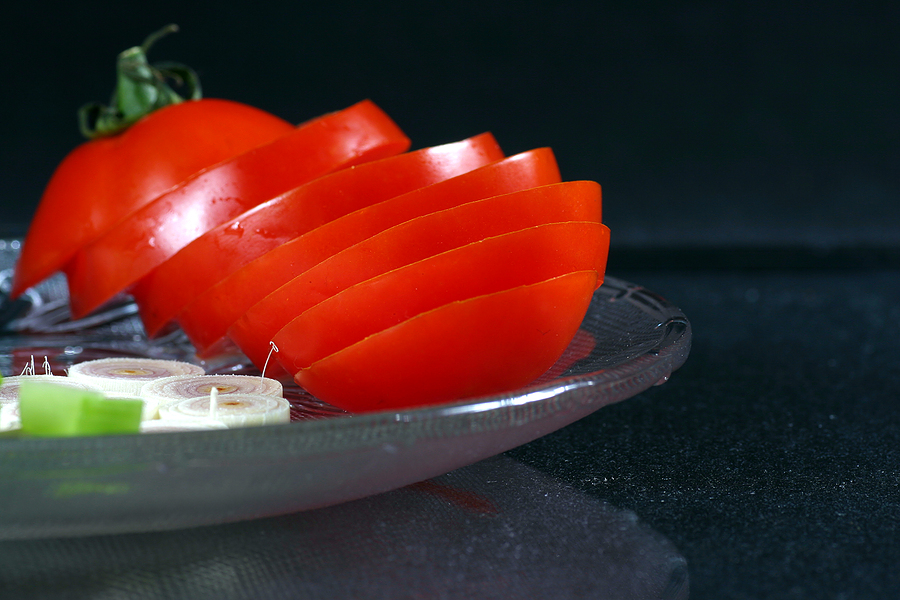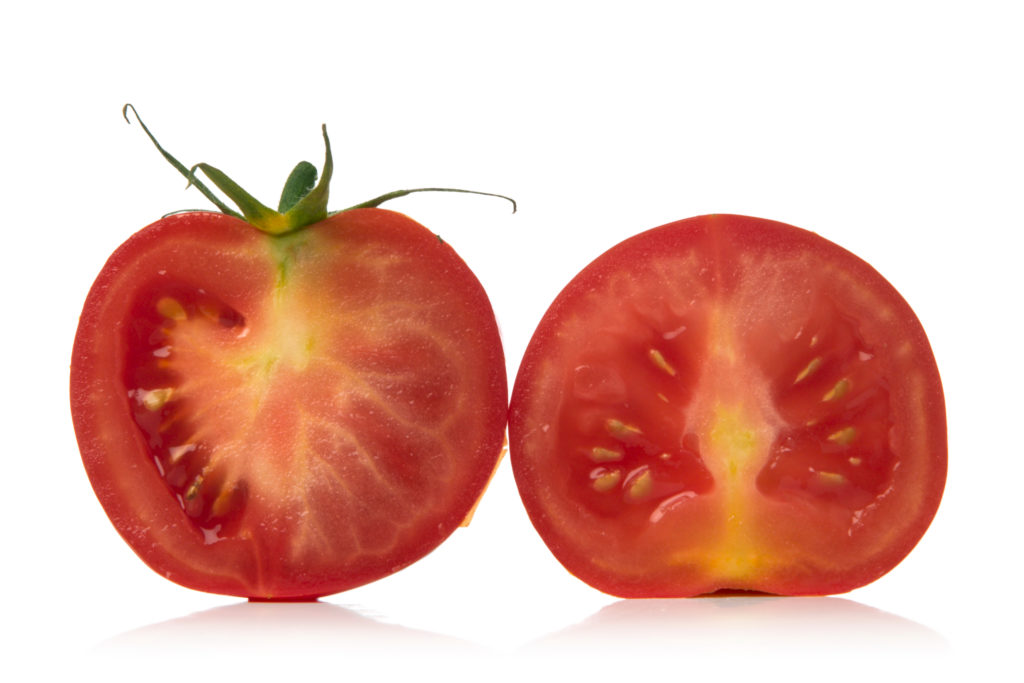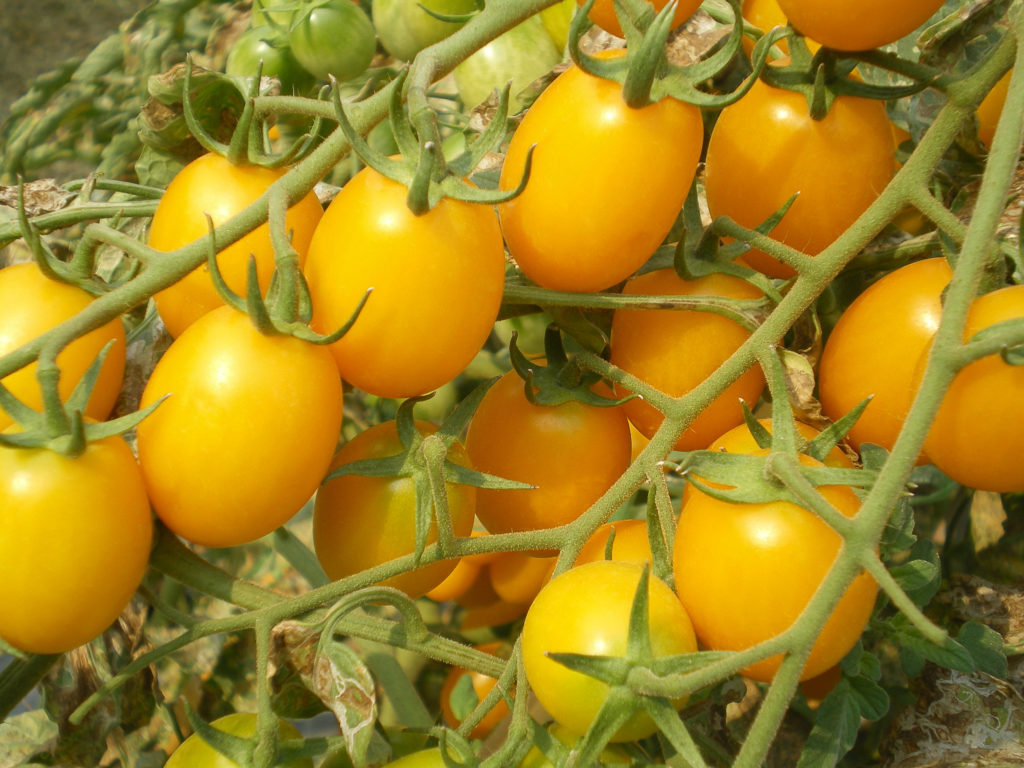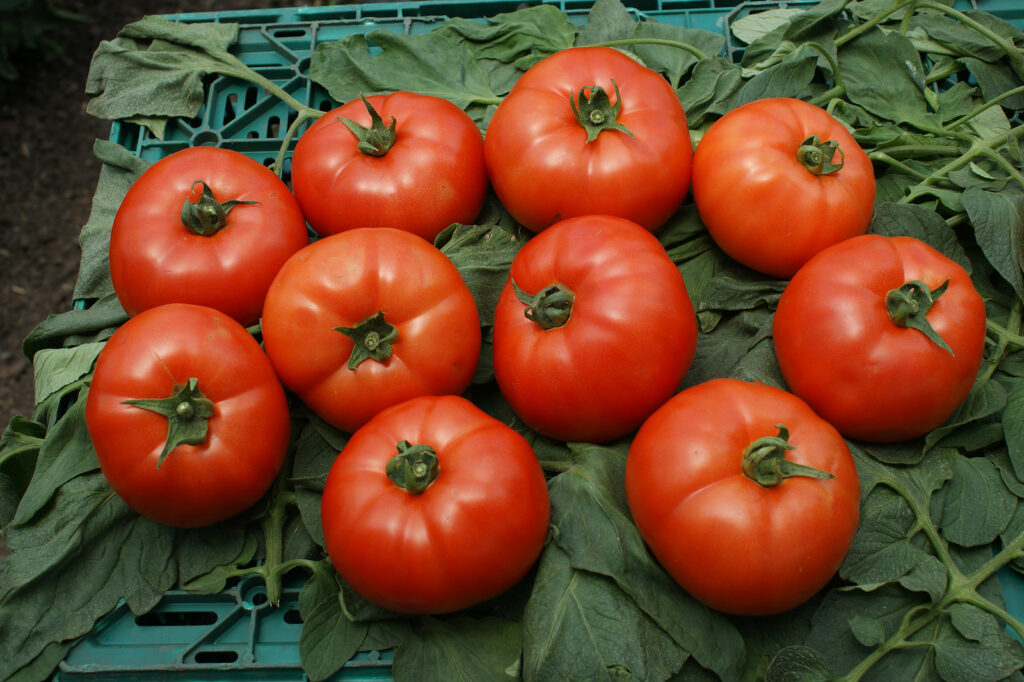Flavor is probably the best reason for selecting a tomato for kitchen garden growing. Once you have identified your favorite tomato (or tomatoes), the memory of that fruit’s flavor will easily get you started in spring and keep you going until harvest year after year. Getting to know new tomatoes and their tastes will bring added pleasure to kitchen gardening. Tasting peak-season, just-picked tomatoes each summer is the best way to come up with your short list of tomatoes to grow next year.

What makes tomato flavor
Tomato flavor is a balance of acid and sugar recognized by the tongue and the effect of volatile compounds within the fruit that cause aroma recognized by the nose. Simply put, the human perception of tomato flavor involves the integration of taste and smell.
Tomato flavor is commonly described as sweet, tart, tangy, or balanced. Tomato flavor is sometimes also described as “classic tomato flavor” or “old-fashioned tomato flavor.” And the flavor of some tomatoes is described as mild or bland.
Sugar in tomatoes
Sugars in the tomato—mainly fructose and glucose—result in a sweet flavor. Acids in a tomato—mainly citric and malic acids—result in a tart, sometimes sour flavor.
Volatile compounds and fragrance
Volatile compounds or oils in the fruit which are released as a fragrance when the fruit is crushed during eating contribute to flavor. Aroma is integrated with taste to create full flavor. There are 15 to 20 assertive volatile compounds in a tomato. (One tomato can have more than 400 volatile compounds.)
The number of sugars, acids, and volatile compounds in a tomato can vary by variety and are mostly genetically determined. However, environmental factors—the amount of sunlight, nutrients, and water a plant receives as the fruit develops—can affect fruit sugar concentrations and the development of volatile substances.
Sweet, acidic, sour, and balanced flavor
Often tomatoes are classed as sweet flavored, acidic or sour flavored, or balanced. A tomato high in sugars and low in acids has a sweet taste. A tomato low in sugars and acids has a bland taste. Traditional tomato flavor—preferred by most people—is a nearly 50-50 combination of sugars and acids; this is often referred to as “old-fashioned” tomato flavor.
Tomatoes described as sweet contain high sugar but low acid content. Tomatoes that are high in acid and low in sugar are described as tart or tangy. Tomatoes with low sugar and low acid levels are often described as bland or mild.
The fragrance of volatile compounds or oils in fruit cells—while neither sugars nor acids (they include amino acids, fatty acids, and carotenoids–pigments)—contribute to the perception of sweetness independent of sugar concentrations. (Volatiles are sniffed through the nose as we chew food—they enter the nasal cavity from the back of the mouth. Volatile signals sent from the back of the mouth interact with taste signals sent by the tongue in various parts of the brain to create flavor.)
Tomato “mouthfeel”
Texture or “mouthfeel” can affect tomato flavor. Heirloom vining tomatoes often have a pulpy texture that is associated with old-fashioned flavor. Greenhouse and determinate tomatoes—often with fewer days to maturity and thus fewer days of exposure to sun and thus the development of sugars—are firm. When texture detracts from the flavor, a tomato is often referred to as mealy.
Flavor, we might say, is in the chemistry of the fruit.

Tomato flavor descriptors
- Sweet: sweet, fruity, tropical, sugary, low-acid, refreshing.
- Sour: tart, tangy, acidic, old-fashioned, tomatoey, assertive, bold, citrus.
- Savory—not sweet or sour (called Umami in Japanese): earthy, rich, complex, meaty, salty, spicy.
- Balanced: balanced, complex, excellent, exceptional, intense, delicious, outstanding, flavorful.
A tomato with high sugar content and high acid content that is rich in volatile compounds is referred to as balanced, rich, and complex.
A tomato with both high sugar and high acid content is referred to as both sweet and tart.
A tomato with high sugar content but low acid is referred to as bland.
A tomato with low sugar content and high acid content is called tart. A tomato with low sugar and low acid content is called tasteless.

Tomato color and flavor
As noted above carotenoids or plant pigments responsible for bright yellow, red, and orange hues in tomatoes produce different balances of sugars and acids.):
- Red and pink tomatoes commonly have higher sugar than acid concentrations.
- Orange, yellow, and white tomatoes are less acidic than red tomatoes and so are mild tasting or the combination of sugar and acid levels and volatile compounds have the effect of a milder flavor.
- Black and purple tomatoes—created by a mix of green and red pigments—are known for their complex flavor—though the acid and sugar levels may be nearly balanced.
- Cherry and grape tomatoes—which can vary in color–have high sugar concentrations and taste sweeter than full-size tomatoes.

Heirloom tomato flavors
- Arkansas Traveler (pink): rich balance of sweet and tart.
- Aunt Ruby’s Green (green): acidity with well-balanced sugar.
- Aussie (red): old-fashioned, robust flavor.
- Big Rainbow (red-orange-green striped): sweet flavor, meaty.
- Brandywine (pink): sweet with notable acidity, old-fashioned.
- Black from Tula (black-purple): sweet, complex flavor.
- Black Krim (black-purple): intense flavor, slightly salty taste.
- Black Prince (black-purple): rich, fruity flavor.
- Carbon (black-purple): exceptionally rich and sweet flavor.
- Carmello (red): “perfect” acid-sugar balance.
- Caspian Pink (pink): sweet tomato with notable acidity.
- Cherokee Purple (dark pink to blackish): complex smoky flavor with a slightly sweet aftertaste.
- Costoluto Genovese (red): old-fashioned flavor, meaty, tart.
- Dona (red): a smaller version of Carmello, a balanced acid-sugar flavor.
- Druzba (red): robust sweet-tart flavor, meaty.
- German Johnson (red): deep, acidic tomato flavor.
- German Pink (pink): full, sweet flavor, floral.
- Gold Medal (marbled yellow-red-green): sweet flavor.
- Great White (yellow-white): mild flavor, low acidity, light sweetness.
- Green Zebra (green): mild flavor, low acidity, some sweetness.
- Japanese Black Trifele (black-purple): deep, chocolatey smoky, rich flavor.
- Juane Flamme (orange): sweet, low-acid, tropical flavor.
- Kellogg’s Breakfast (orange): sweet flavor, meaty.
- Limmony (yellow): zesty, citrusy flavor.
- Matt’s Wild Cherry (red): sweet, full flavor.
- Mortgage Lifter (pink): mild sweet flavor and meaty texture.
- Moskvich (red): rich flavor.
- Paul Robeson (black-purple): complex, smoky flavor.
- Persimmon (orange): sweet flavor, meaty.
- Pineapple (orange-red striped): very sweet, with low acidity.
- Pruden’s Purple (pink): sweet, juicy, meaty.
- Purple Calabash (black-purple): rich, full old-fashioned flavor blending sweet and acid.
- Purple Russian (black-purple): meaty, sweet flavor.
- Striped German (yellow-red-green striped): sweet flavor, soft texture.
- Stupice (red): rich, tangy flavor.
- Thessaloniki (red): earthy, classic flavor, meaty.
- Vorlon (black-purple): a cross between Prudens Purple and Cherokee Purple, meaty, rich, sweet flavor.
- Yellow Pear (yellow): very sweet.

Tomato flavor matches
Tomatoes fresh from the garden—medium or large ones—sliced or cherry tomatoes halved and arranged on a plate and served with flavor matches take little time. Serve sliced tomatoes every day with a different flavor match—you will not run out of flavor combinations from the first picked tomato to the last.
Choose one or two medium tomatoes per person if tomatoes are the heart of the meal. Slice tomatoes horizontally, not vertically—that is across the equator. (Wedges are sliced stem to blossom end.) Quarter-inch slices will work perfectly. Discard the stem and blossom ends.
Most simply: tomato slices can be drizzled with a little extra-virgin olive oil and sprinkled with kosher salt and freshly ground black pepper. You’ll want crusty bread to soak up the juices on the plate.
You won’t have to work hard to discover combinations that are flavorful. Salt and pepper, olive oil, vinegar, or vinaigrette will work with any of the combinations here. Keep tasting to find the flavor matches you like best.
- tomatoes + vinegar (balsamic, raspberry, red wine, rice, sherry, tarragon, white, wine)
- tomatoes + salt + pepper + lemon juice + cider vinegar + mozzarella cheese
- tomatoes + avocado + jalapeño mayonnaise
- tomatoes + bacon + bittersweet lettuce
- tomatoes + cucumber + olive oil
- tomatoes + hard-cooked egg + salt
- tomatoes + toasted bread + garlic rub + olive oil + salt
- tomatoes + mushroom garnish
- tomatoes + sliced onions (red, sweet, Vidalia)
- tomatoes + prosciutto + mozzarella cheese + olive oil
- tomatoes + Italian parsley + garlic + olive oil
- tomatoes + Italian parsley + minced garlic + grated hard cheese (Dry Jack, Parmesan, Romano, Asiago)
- tomatoes + arugula + vinaigrette
- tomatoes + lemon basil + olive oil
- tomatoes + bell peppers + olive oil or vinaigrette
- tomatoes + minced garlic + shaved Parmesan cheese
- tomatoes + slices of mozzarella fresca + olive oil
- tomatoes + lemons + olive oil
- tomatoes + minced garlic + lemon cucumber + bell pepper + olive oil
- tomatoes + cheese (blue, goat, Gorgonzola, mozzarella, Parmesan, pecorino)
- tomatoes + chile peppers
- tomatoes + chives
- tomatoes + cilantro + jalapeño or Serrano chiles + olive oil
- tomatoes + cucumbers
- tomatoes + lemon
- tomatoes + olive oil
- tomatoes + sliced green olives + olive oil
- tomatoes + black olives
- tomatoes + lemon + tuna
- tomatoes + sweet red onion + anchovy filets + olive oil
- tomatoes + feta cheese + anchovy filets + olive oil + minced oregano
- tomatoes + parsley + olive oil
- tomatoes + minced garlic + grated cheese + chopped preserved lemons + olive oil
- tomatoes + feta cheese + oregano + chopped red onions + red wine vinegar
- tomatoes + grilled sweet onions + bacon + balsamic vinaigrette
- tomatoes + avocado + basil + crab
- tomatoes + avocado + lemon
- tomatoes + basil + chervil + garlic + tarragon
- tomatoes + basil + goat cheese
- tomatoes + basil + mozzarella cheese + garlic + olive oil + balsamic vinegar
- tomatoes + basil + olive oil + orange juice + prosciutto + watermelon
- tomatoes + basil + oregano + thyme
- tomatoes + basil + ricotta cheese
- tomatoes + chile peppers + garlic + onions
- tomatoes + fennel + Gorgonzola cheese
- tomatoes + garlic chives + lemon basil
- tomatoes + horseradish + lemon
- tomatoes + olive oil + balsamic vinegar
- tomatoes + frisée + watercress + balsamic vinegar
- tomatoes + raspberry + basil + vinegar
- tomatoes + mozzarella + ham + jalapeño + basil
- tomatoes + cucumber relish + parsley
- tomatoes + crème fraĩche + fresh herbs
- tomatoes + watermelon
- tomatoes + peppers + onions + bread + almonds
Related articles:
How to Plant and Grow Tomatoes
How to Harvest and Store Tomatoes
Nine Ways to Cook and Serve Tomatoes
Tomato articles at Harvest to Table:
How to Plant and Grow Tomatoes
How to Choose a Tomato for Your Garden
Growing Tomatoes in Containers
Growing Early Season Tomatoes for Great Taste
Epsom Salt, Milk, and Organic Fertilizers for Tomatoes and Peppers
How to Prevent Blossom Drop – Tomatoes and Peppers
How to Harvest and Store Tomatoes
Nine Ways to Cook and Serve Tomatoes
Tomato Sauce–Basic, Herbed, or Vegetables Added
How to Make Tomato Juice Simply
How to Home Can Tomatoes for Beginners
How to Sun Dry and Oven Dry Tomatoes
Tomato Growing Problems Troubleshooting
How to Prevent Tomato Blossom Drop
How to Identify Early Blight, Late Blight, and Leaf Spot
Tomato Hornworm Organic Pest Control
Garden Planning Books at Amazon:
- Vegetable Garden Almanac & Planner
- Kitchen Garden Grower’s Guide Vegetable Encyclopedia
- Vegetable Garden Grower’s Guide
- Tomato Grower’s Answer Book















